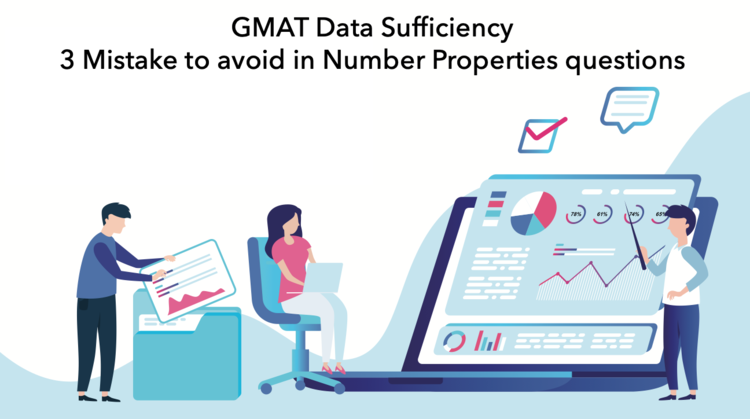Typical GMAT data sufficiency questions are followed by information in the form of two or three statements. You have to figure out which statements you need to correctly answer the question. Many students who do reasonably well in problem-solving questions continue to struggle with GMAT data sufficiency questions. Students often realize that they couldn’t answer GMAT DS questions correctly despite knowing the concepts being tested in the question. This article is designed to understand why these people make mistakes and essentially, how they can reduce or eliminate making those mistakes.

Agenda of the Article
A major part of solving a GMAT Data Sufficiency question correctly involves inferring the information from the question stem and, this is an area where students typically falter when they mistake. To help you, we will discuss three major mistakes that students make while applying inferences in a GMAT DS question.
These 3 mistakes are:
- An incorrect inference drawn from question stem
- An incomplete inference from question stem
- Faltering while applying the inferences
We will take one question each to discuss the above 3 types of mistakes and, all the questions are e-GMAT practice quiz questions, so we will also provide the accuracy and the total number of forum queries for each question.
Questions on Number Properties are very commonly asked on the GMAT. Ace GMAT Quant by signing up for our free trial and get access to 400+ questions. We are the most reviewed online GMAT Prep company with 2400+ reviews on GMATClub.
Let us discuss the first mistake.
Mistake 1: Incorrect inference from the question stem
Many times, a student knows exactly how to solve a question correctly – he knows all the concepts, he even has all the processes in his mind, but all the learnings fail when he makes an incorrect inference to hasten the process of question solving.
In mistake 1, we will look at one e-GMAT Practice question where students have made this type of mistake.
Let us look at the question first.
Question 1- GMAT Data Sufficiency – Number Properties
x, y, and z are positive integers, where x is an odd number and z = x2 + y2 +4. Is y2 divisible by 4?
- z = 8k – 3
- (z – x + 1) = 2q + 1
(For e-GMAT students: This question is present in Even-Odd practice quiz of Number properties module)
- Accuracy of the question: 55.10%
- Total forum post queries posted for this question: 14
- We know that 45% of the students got this question wrong and out of this 45%, 40% of the students got this one wrong despite knowing the required concepts.
So, let us understand this question!!
Given:
- x, y, and z are positive integer and x is an odd number.
- z = x2 + y2 + 4
Inference from the given information:
- z = Odd + y2 + Even
- z = Odd + y2 (As Odd + Even = Odd)
To Find:
We need to find whether y2 is divisible by 4 or not.
Inference from what we need to find:
Now, let us first look at one incorrect inference.
Learn how Carrie improved from Q35 to Q50 in just 3 weeks to score a 750
Student’s Mistake- Incorrect Inference
Notice the highlighted part of this query.
Now, is there anything wrong in this inference drawn by student?
- It is actually partially incorrect.
- The reason is that student is considering only those values of y that are divisible by 4.
- What if y is divisible by 2 only and not 4?
- For example: y = 2 or 6 or 10?
- Is y2 = 4 or 36 or 100 not divisible by 4?
- It is.
- For example: y = 2 or 6 or 10?
Correct Inference
Hence, the correct inference is that if y is divisible by 2 then y2 will be divisible by 4.
- Or, essentially if is even then y2 is divisible by 4.
So, if you focus on processing information in the correct manner then you can get the question correct.
- The best thing is you don’t need to learn any new concepts, it is only about developing good habits i.e. following step by step and methodical process.
How to avoid drawing incorrect inferences
- First reason why student make this mistake is because Drawing inferences from question stem is not a part of their process to solve a DS question.
- Basically, they start to draw inferences from the statements and that is how they make this mistake.
- So, make sure to include this step in you process.
- Secondly, you might be drawing inferences from question stem, but you rush to solve the question.
- So, you make incomplete inferences.
- And, by focussing on processing the information, you can get the question correct.
- It might happen that you are not rushing through the question and you are also inferring information from question stem, but you actually don’t have the depth/capability of understanding to draw inferences.
- You should use these questions as an opportunity to learn and you will improve as you keep on practicing questions.
Mistake 2: Incomplete inference from the question stem
This is the second type of mistake where student infers incomplete information from the question.
To understand what I really mean by incomplete inference, let us look at another e-GMAT question.
Question 2 – GMAT Data Sufficiency – Number Properties
The number x is a positive odd integer. If the unit digit of x3 is subtracted from the unit digit of x2, it results in 0. What is the unit digit of the number x + 7?
- The unit digit of the product of 105 and x is 5.
- When x is divided by 5, it leaves no remainder.
(For e-GMAT students: This question is present in units digit practice quiz of Number properties module)
- Accuracy of the question: 44.47%
- Total forum post queries posted for this question: 14
- Out of the 55% who got this question wrong, 35% of the students got this one wrong despite knowing the required concepts.
Let us understand why this happened.
Given:
- x is a positive odd integer.
- When the unit digit of x3 is subtracted from the unit digit of x2, it results in 0.
Inference from the given information:
Let us look at incomplete inference first.
Student’s Mistake: incomplete inference
This student thinks that 105 is ending with 5 and its multiplication with another number is also ending with 5.
- So, he does some calculation in the back of his mind that:
- 5*5 ends with 5
- 25* 5 also ends with 5
- 125* 5 also ends with 5.
- Therefore, x should be 5.
Now, all of you know that this is incomplete inference.
But, before reading further, I want you to find the correct inference by yourself.
Correct Inference
Since units digits of x3 and x2 are resulting in 0, we can say that their units digits are equal.
- Units digit of x3 = Units digit of x2
Hence, we can say that the cyclicity of x is 1.
- Therefore, the possible units digit of odd integers with cyclicity 1 can be either 1 or 5 and not just 5.
For example:
- For x=11, last digit of (105 × 11) = last digit of (5 × 1) = 5.
- For x=31, last digit of (105 × 31) = last digit of (5 × 1) = 5.
- For x=35, last digit of (105 × 35) = last digit of (5 × 5) = 5.
- For x=65, last digit of (105 × 65) = last digit of (5 × 5) = 5.
So, the student made two mistakes.
- He forgot to consider that the units digit of x can also be 1 which is an incomplete inference.
- He also relied on number substitution which gives wrong answers in many questions.
- The reason is simple. You take only one value and does not think for other possible values.
- As we saw in this question that last digit 5 works but it is not the only value of last digit of x that works.
And, do you know that test maker also forms a question by keeping in minds these traps.
- Want to see how…?
Let us read statement 1.
Statement 1: The unit digit of the product of 105 and x is 5.
- Units digit of (105 × x) = 5
For units digit of x =1 or 5, the units digit of (105 × x) is 5. For example:
- Units digit of (105 × 11) = Units digit of (5 × 1) = 5.
- Units digit of (105 × 25) = Units digit of (5 × 5) = 5.
If the student draws incomplete inference and considers only 5 or only 1, then he will think that statement 1 is sufficient to answer and that is how he will fall into trap.
- And, the only solution to ensure that one does not fall into these kinds of traps is to completely and correctly infer all the information present in the question.
How to avoid drawing incomplete inferences
- You can avoid making incomplete inferences by following a proper step by step and a methodical approach in every DS question.
- As in this question, we first found that cyclicity of x is 1 and then we found two possible values of x rather than directly coming to a value without proper analysis.
- This ensures that we are not missing out any inference that might be useful to solve a question correctly.
So, we have learned to avoid 2 most common mistakes in DS questions.
We will discuss “Mistake 3: Faltering while applying the inferences” in the next article.
Takeaways from this article – GMAT Data Sufficiency – Number Properties
- We discussed how important it is to draw inferences from question stem.
- Please understand that the question statement provides important information that needs to be processed and inferred.
- If this step is still not in your process, do add this and your accuracy will improve.
- If you rush through things, then make sure you don’t do that because you might miss out some important inferences.
- Make a conscious effort to not rush through things. To start off, you can even assign yourself 45 sec-1 min to process information and with practice, this process will happen automatically every time you will solve a question.
- It might happen that you actually don’t have the capability to draw those deep inferences in certain questions and it is in a way good.
- You can use those questions as a learning opportunity
- Write down the inferences from the question that you were unable to solve and revise those question so you don’t make those mistakes again.
Want to read more articles like this?
Now, if you liked this article on GMAT data sufficiency, then I am sure that you want to read some more articles like this.
To read all our articles go here:
You will also get a lot of practice questions to learn from.
Happy learning.
If you are planning to take the GMAT, we can help you with a personalized study plan and give you access to quality online content to prepare. Write to us at acethegmat@e-gmat.com. We are the most reviewed GMAT prep company on gmatclub with more than 2400 reviews and are the only prep company that has delivered more than 700+ scores than any other GMAT club partner. Why don’t you take a free trial and judge for yourself?












